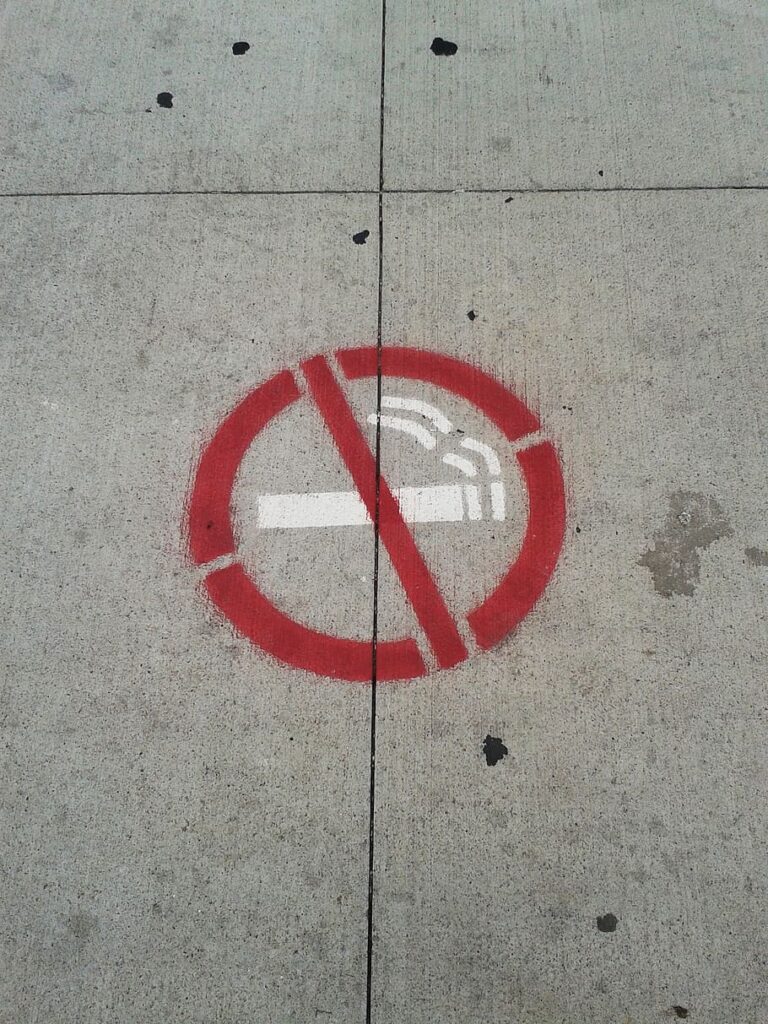Top Tips & Benefits to Quit Smoking – Quitting Time!

BY TRACEY HORDERN
While daily smoking has consistently declined in Australia for the last four decades, in 2019 some 11 percent of Australians still smoked tobacco daily.* This has far-reaching health implications, given that smoking is the leading cause of cancer in Australia, accounting for 22 percent of the health burden.
According to a survey by Quit Australia approximately 80 percent of daily smokers want to give up.*** So, what is it about smoking that involves people continuing with the dangerous and expensive habit against their will? In a word; it’s nicotine.
An addictive substance that swiftly delivers a powerful effect to the brain, nicotine can be difficult both physically and mentally to quit – though it is entirely possible and extremely liberating.
While some people successfully quit from their first attempt, the majority of smokers achieve long-term, non-smoking status after several attempts. The strong message to smokers; is don’t give up on quitting.
Benefits of Quitting Smoking
Quitting smoking can be stressful at first, but after six months, you may find that your stress levels and mood could be even better than when you smoked. Your overall health will improve in the first few months after quitting. Your heart and lungs will benefit and blood flow to your hands and feet will increase, and your immune system will improve.
The earlier you quit, the greater the health benefit. However, quitting at any age will reduce your risk of:
- Heart disease
- Stroke
- Cancer
- Chronic bronchitis
People who quit smoking by the age of 30 avoid most smoking-related diseases. They live, on average, 10 years longer than they would have if they had kept smoking. Even quitting at the age of 60 means that, on average, you are healthier and live a few years longer. If you already have a smoking-related disease, quitting will improve your condition and help with your treatment, compared to someone who continues to smoke.
Benefits Timeline*******
You will feel the benefits of quitting almost straight away as your body repairs itself. Depending on how much you smoked, you should start seeing some benefits in a week. The following is a breakdown of the benefits you can expect over time periods.
The First Month
- In 12 hours, excess carbon monoxide is out of your blood
- In 5 days, most nicotine is out of your body
- In 1 week, your sense of taste and smell improves
- In 1 month, your skin appearance is likely to improve
The First Year
- In 2 months, your lungs will no longer be producing extra phlegm caused by smoking
- In 3 months, your lung function and blood flow will improve
- In 12 months, your risk of heart disease has halved
Longer-Term Benefits
- In 5 years, your risk of a stroke will dramatically decrease
- In 10 years, your risk of lung cancer is less than half that of a continuing smoker and will continue to fall
- In 15 years, your risk of heart attack and stroke is almost the same as that of a person who has never smoked
Strategies to Quit Smoking****
The good news about quitting smoking is there is now a wide range of help available. For the greatest chance of success, it is helpful to be open-minded to all the evidence-based quit-smoking aids. The benefit of being open-minded is if one strategy doesn’t work, you can try another, or even combine strategies and aids. There is no one ‘right’ way to quit. Whatever works for you to successfully quit and remain smoke-free is the right way.
Will Power
Everyone will use some willpower on their personal quit journey to get through cravings. But it’s important to know that the ‘cold turkey’ quit method alone has a low success rate compared to other quit smoking methods. In other words, combining willpower with an evidence-based quit smoking method, gives you a much better chance of success compared to using willpower alone.
Nicotine Replacement Therapy (NRT)
Nicotine is one of the main causes of smoking dependence. Yet unlike the tar and the harmful chemicals, including carbon monoxide found in tobacco smoke, nicotine does not cause cancer. For many people, Nicotine Replacement Therapies can be really helpful as they release a smaller, measured dose of nicotine through products available at pharmacies such as Nicotine Gum, Nicotine Inhalers and Sprays, Nicotine Patches and Nicotine Lozenges.
Prescribed Quit Smoking Medications
Quitting smoking using prescribed medication involves the use of non-nicotine medications that are only available with a prescription from a doctor. In Australia, there are two types of prescribed medication designed to help people quit smoking. One is sold under the brand name Champix, the other us sold under the brand name Zyban SR in Australia. Discuss with your GP about these options and whether they would be beneficial to you.
Professional and Online Support
Seeking support from a qualified health professional is a great way of enhancing your own strengths and abilities. Phone calls to the NSW Quitline can increase your chances by 25-50%. One-on-one counselling offers a 40% increase and Quit smoking advice from your doctor can increase your chances by 66%. Combining any one type of professional support with Nicotine Replacement Therapy (NRT) or a prescribed quit smoking medication gives you a huge 70-100% increase in your success rate of quitting. ****

Top Ten Tips to Quit
Smoking is the number one cause of preventable disease and death in Australia. By quitting you are doing one of the best things you can do to improve your health and reduce your risk of cancer. This applies no matter how long you have smoked. Following are some of the best tips to help you quit – and to stay smoke-free.
- Set a Quit Date
Setting a quit date can help you prepare mentally and physically for the upcoming positive change in your life. Like any type of goal setting, it can help motivate you to make the change. Select a day that works best for you to stop smoking. You can talk to Quitline by calling 13 7848 (13 QUIT) to help you choose your quit day and begin preparing. The day before your quit day, throw out all your tobacco products, lighters and ashtrays in your house, car and workplace.
2. Address your Triggers
By knowing your triggers, you can regain control of a variety of situations. Regardless of what your triggers are, as a guide – mix things up. Different can definitely be better, for instance, you may find you enjoy starting your day with exercise rather than a cigarette. But you still may love that morning coffee, so rather than getting your caffeine fix with a cigarette, enjoy your coffee with a non-smoking friend in a café. When it comes to spending time with smokers, consider seeing your smoking friends in a situation where smoking is not possible, such as a cinema or restaurant.
3. Get Free Support
You have a better chance of quitting and staying quit if you speak with an Advisor at Quitline. You do not need to be ready to quit straight away, Quitline can help you prepare to quit, and support you in creating a quitting plan that works best for you.
4. Get Support from Your Doctor
Your doctor or pharmacist can help with products and quit plans. Nicotine Replacement Therapy helps to manage cravings and withdrawal symptoms to make for a smoother quitting journey.
5. Reduce your Caffeine &/or Alcohol
Many people find drinking alcohol and caffeine trigger the craving for smoking. Stopping all coffee and alcohol can be hard when you are attempting to quit smoking. Try instead to change your routine or reduce the amount of coffee and alcohol you drink.
6. Get Support with Quitly
Quitly is an automated chatbot on Facebook Messenger designed to help you quit smoking.
Through Messenger, Quitly gets to know a bit about you by asking questions that assist it in tailoring support just for you. Whether it is your first attempt or you have tried to quit a few times, Quitly is a great motivation tool to help you understand your smoking triggers and ultimately help you succeed in quitting.
7. Plan Your Rewards
Someone who smokes a packet a day can save around $10,000 a year if they do not smoke – and this amount is increasing regularly. To add to your motivation, add up the amount of money you can save – and plan how you could use that money to reward yourself.
8. Stay on Track with Free Quit Smoking Tools
Use the My Quit Plan to help you track your smoking, set a quit date and get email support. The My Quit Plan will also track how much money you save not smoking.
9.Use Mobile Apps for Support
Quit smoking support apps are useful when you are on the go, providing a variety of support to help you achieve your goal of quitting.
10. Get Help from Ex-smokers
Empathy is a powerful tool, with other people who have quit knowing what you are going through and how you feel. The iCanQuit site has some great stories and tips of ex-smokers. You can also lean on family and friends who have quit smoking. You’ll likely find that they are more than happy to help by sharing their story.
From Quitter – To Staying Stopped
The Quit website has many tips to help you deal with problems with quitting as come up.
Dealing with cravings when quitting smoking can be challenging, but not impossible and remember, cravings only last a few minutes. If you conquer your cravings, you’ll conquer cigarettes.
To Combat Cravings, use the 4Ds:
- Delay acting on the urge to reach for a cigarette.
- Take Deep breaths.
- Drink water.
- Do something else to occupy your mind while your craving passes.
If You Slip Up & Smoke
It’s hard to quit smoking, especially if you’ve been smoking for a long time. If you slip up and have a cigarette, don’t be hard on yourself —it doesn’t mean you won’t be able to quit. Focus on your success, and remind yourself how long you’ve gone without smoking and get back on your quit path – as soon as possible. It’s helpful to know that most people who have quit smoking for good have done so, after several attempts.
Digital Support Services
- The Quitline — call 137 848 between 8am and 8pm Monday to Friday, to talk to a counsellor or ask for a call back service or visit https://www.quit.org.au
- Quit Pack — ask the Quitline for this free pack. It contains useful information including: a book to help you prepare, a guide to choosing the best way for you to quit, and a handy wallet card with tips to cope with cravings.
- QuitCoach — an online tool that asks questions about your smoking habits and lifestyle. By using this information, you create a quit plan that is tailored specifically for you.
- The Quit Because You Can booklet is part of the Quit Kit. This booklet includes information to help you learn about why you smoke and describes different ways of quitting. No matter where you are in your quit journey, this booklet has detailed and helpful advice for you.
- My QuitBuddy is a free mobile phone app designed to support and encourage you to quit smoking. It lets you set personal goals, track your progress and see how much money you’ve saved. Alerts and other messages help keep you on track and support is available from the many other people using the app.
- Visit the I Can Quit siteat: https://www.iCanQuit.com.au
- Visit Quit Org at: https://www.quit.org.au/
- Call the Quitline on 13 7848
Where to Get Further Help
Visit your General Practitioner to discuss the best options and support available to assist you to quit smoking – for good.
References:
*Cancer Institute of NSW
**Australian Institute of Health and Welfare
https://www.aihw.gov.au
**** I Can Quit
https://www.icanquit.com.au/
*****Quit Org
https://www.quit.org.au
******Better Health Channel
https://www.betterhealth.vic.gov.au/
*******Australian Department of Health
https://www.health.gov.au/



